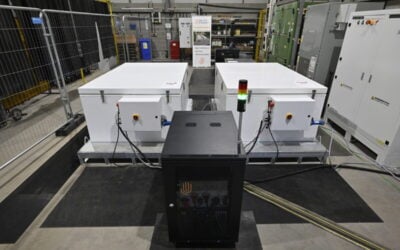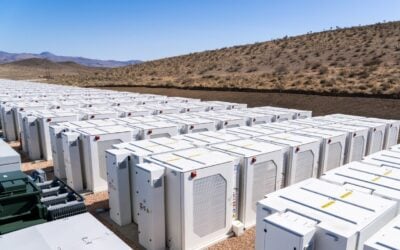Stem far outpaces other energy storage vendors in SGIP process with 175 completed projects over the life of the programme. Source: Stem Inc.
The California Public Utilities Commission (CPUC) issued a decision that reforms its Self-Generation Incentive Programme (SGIP) to provide US$83 million a year until 2019 for behind-the-meter technologies, not least, energy storage.
The SGIP’s mandate is to provide financial incentives for the installation of distributed generation technologies. The programme is also funded by ratepayers via its rebate scheme and is available to retail electric and gas customers of investor-owned utilities in the state. The revised SGIP allocates 75% of programme funds to energy storage – with 15% of that specifically diverted to residential projects. The remaining 25% is to be allocated for generation.
The programme is applicable to all technologies that meet its performance and reporting standards and the greenhouse gas (GHG) reduction requirement.
Half of the US$83 million allocated for this year to finance technologies was awarded in a bidding process in February. The second half will be awarded later this year once the CPUC have ruled on legislatively mandated reforms to the programme.
Try Premium for just $1
- Full premium access for the first month at only $1
- Converts to an annual rate after 30 days unless cancelled
- Cancel anytime during the trial period
Premium Benefits
- Expert industry analysis and interviews
- Digital access to PV Tech Power journal
- Exclusive event discounts
Or get the full Premium subscription right away
Or continue reading this article for free
‘Big win for the industry’
“The 75% budget allocation is a big win for the industry,” said Ravi Manghani, GTM Research’s director of energy storage. “It’s a validation that energy storage can be the principal technology to achieve this renewed GHG reduction objective, as it can help improve overall system GHG efficiency when paired with solar and other renewables, or even as a stand-alone resource.”
The higher incentive level for storage clearly reflects the direction the programme is headed and has been heading for the last couple of years. It also makes economic sense given that energy storage was the strongest performer in terms of installed capacity in the state. Manghani added that the new funding is to be viewed as a ceiling, and not a floor.
In fact, funding for SGIP storage projects in 2015 was US$67 million; more than double the US$33 million that was approved last year for fuel cell projects. These figures, among other analysis, sparked a posturing of ‘fuel versus energy storage’. Notably, storage funding submissions online were monopolised by energy storage provider Stem, which managed to secure 56 applications out of the first-come, first-served application process.
Approved SGIP funding by programme year (Million US$). Source: GTM Research
That triggered part of the revision of the administration process that the CPUC recently approved. Now, the selection process has been amended to include a lottery system when applications received on the same day request more incentives than the remaining budget holds. In addition, projects that have addition GHG or grid benefits are prioritised within the lottery. The CPUC have deliberately avoided using a standard competitive bidding process to honour the programme’s mission to incentivise emerging technologies and smaller vendors.
Key amendments approved the SGIP also mean that energy storage incentives are decreased from US$1.31/W at the beginning of this year to between US$0.50/Wh and US$0.30/Wh.
“This I think is a good modification,” said Manghani. While the incentive is technically lower than the previous version of SGIP, it’s not a significant decline. The 2016 incentive cap for a two-hour system was US$0.66/Wh (i.e. US$1.31/W), it’s been lowered to US$0.50/Wh. This ~US$0.16/Wh is still significant considering that the total eligible costs for large commercial/industrial systems submitted in Q1 2016 are already under US$1,500/kWh.
“If anything, this will spur more competition, and the lower project cap will see the SGIP budget benefiting more number and megawatt-hours of projects. By explicitly changing the incentive to US$/Wh, it can boost adoption of several long duration storage technologies.”
Proposed incentives for energy storage technologies over five steps. Source: California Public Utilities Commission
Summary of changes
The superseding version of the SGIP made additional funds available every year. The reforms implemented mean that the SGIP will be administered on a continuous basis with incentive levels declining based on the capacity reserved in the programme.
In addition, beginning in 2017, generation projects consuming natural gas must use a minimum of 10% biogas to receive an incentive. The minimum requirement increases to 25% in 2018, 50% in 2019, and 100% in 2020.
A further modification now dictates that each participating project developer will be capped at 20% of the incentive budget across the state; replacing the 40% cap that applied to equipment manufacturers. Eligibility for the California Supplier adder now also requires third-party certification to show that at least half of value added occurs in California.
The revised SGIP also removes previous limits placed on projects that take the ITC when paired with solar PV; which could mean that certain projects could cover 100% or more of their storage costs. the arguable biggest triumph is that the modifications to the programme means that storage no longer directly competes directly with fuel cells as now their funded budgets are demarcated.
“It’s too early to say how, if any, design shortcomings will be taken advantage of,” said Manghani, given the controversial nature of the programme in the past. “The modifications make the programme less susceptible to manipulation. If there’s one area that could be seen as a weakness is that while the program introduced a 20% developer cap, it eliminated the previous 40% manufacturer cap. This could be good news for Tesla in particular, given its already strong showing in SGIP applications thus far (even with the manufacturer cap in place).”
Reforms putting ‘California at the forefront of distributed energy’
Despite arguably still having faults, the changes to the SGIP prompted the Energy Freedom Coalition of America (EFCA) to praise the CPUC for its reduced funding to fossil fuels and bolstered support for energy storage and renewable technologies. It is expected that it is these innovative and clean technologies that will help California achieve its ambitious energy and climate goals.
“[T]he CPUC made a decision that keeps California at the forefront of distributed energy, and the development of the clean energy products that will make the world a better place,” said Genevieve Dufau-McCarthy, of EFCA member company SolarCity. “We are grateful for all five Commissioners who supported the reforms and especially president Michael Picker for proposing the reforms, which will help enable distributed clean energy development in the state.”
The full CPUC decision can be viewed here.





